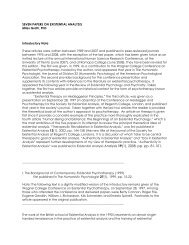The Sonate auf Concertenart: A Postmodern Invention? David ...
The Sonate auf Concertenart: A Postmodern Invention? David ...
The Sonate auf Concertenart: A Postmodern Invention? David ...
You also want an ePaper? Increase the reach of your titles
YUMPU automatically turns print PDFs into web optimized ePapers that Google loves.
<strong>Sonate</strong> <strong>auf</strong> <strong>Concertenart</strong>, p. 41<br />
dialectical structure with bilateral symmetry. Within such a movement, the alternation between<br />
tutti and solo that initially might occupy one's attention fades somewhat in relative significance, as<br />
the solo part is contrapuntally interwoven with the others and other formal principles come into<br />
play. <strong>The</strong> opening ritornello is never repeated in its complete form, and in this connection it is<br />
worth remembering that an opera-seria aria often contains a complete ritornello only at the<br />
beginning of the A section; there may not be any other ritornellos except at the end of the A<br />
section, both then being in the tonic. It is true that Vivaldi, Albinoni, and others were regularly<br />
incorporating greater numbers of full or partial ritornellos in quick concerto movements by 1710<br />
or so. But the aria, with its smaller number of ritornellos and somewhat more substantial role for<br />
the soloist, must have presented an equally influential model for Bach and others.<br />
Similar considerations apply to the Fourth Brandenburg Concerto, whose first movement<br />
has been regarded as both a ritornello form with an unusually long first ritornello and a da-capo<br />
113<br />
form with a disproportionately short A section. Both analyses have points in their favor, but,<br />
like the broadly comparable preludes of English Suites nos. 1-5--which might have been<br />
preliminary compositional essays for movements of this type--the movement represents an almost<br />
unique type, invented by Bach around 1713, that could not have appeared more than a few years<br />
earlier or later: not much earlier, since the solo concerto with its principle of alternation between<br />
tuttis and solos (on the model of the virtuoso aria) had not yet been invented, not much later,<br />
since by 1725 or so what we now understand as through-composed ritornello form was being<br />
routinely employed in the quick movements of virtually all concertos. 114<br />
What Bach has done in such works is not so much to combine genres as to employ a<br />
diverse set of conventional compositional devices, especially those that articulate form, in original<br />
and unique ways. This is, of course, generally recognized as one of the defining features of his<br />
style. My proposal would, however, enhance our appreciation of Bach's originality, for we would<br />
have to understand the relatively youthful composer of the English Suites, the Weimar organ<br />
chorales and preludes, and the Brandenburg Concertos as grappling with new and potentially<br />
powerful modulatory and articulatory techniques, in genres that were not yet understood<br />
according to the sharply drawn formal structures and style categories delineated in modern<br />
textbooks. Bach nevertheless managed to create works that are both coherent and rich in their use<br />
In his account such designs resemble variation forms rather than, as here, the A section of an<br />
operatic aria containing two main statements of the first stanza of the text.<br />
113<br />
Butler, "<strong>The</strong> Question of Genre," 9, designates it "sonata da capo form."<br />
114<br />
<strong>The</strong> Fourth Brandenburg Concerto has also elicited debate as to whether it is "a solo<br />
concerto for violin with ripieno strings and woodwinds, or . . . a concerto grosso for a concertino<br />
of violin and woodwinds with ripieno strings," as Marissen puts it in <strong>The</strong> Social and Religious<br />
Designs of J. S. Bach's Brandenburg Concertos (Princeton: Princeton University Press, 1995),<br />
62. As Marissen suggests, this is a false dichotomy, although his argument that here Bach was<br />
"moving beyond the two-way (concertino/tutti) textural contrast of the traditional baroque<br />
concerto" (64) runs against the grain of what has been said here about Baroque "tradition" in such<br />
works.















